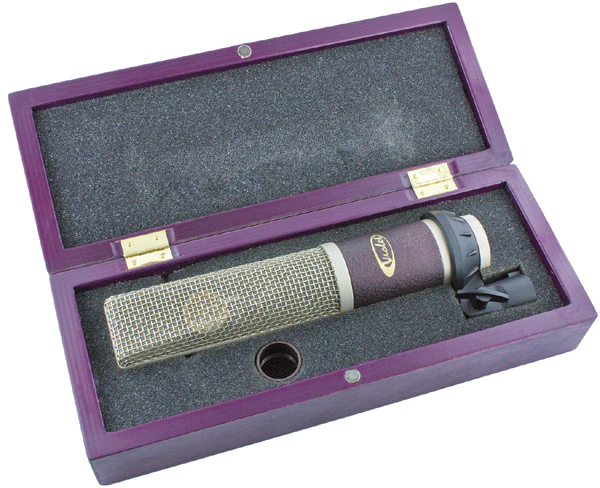
Barry's Mix Magazine Equipment And Software Reviews
Barry's Massive Discography And Engineering Career
Barry's Music Connection Magazine Reviews
Barry's Resolution Magazine Reviews
Violet Design Wedge Microphone
By Barry Rudolph

Noted for the striking industrial designs of its products, Violet Design debuts the distinctive-looking Wedge--a single-diaphragm, cardioid condenser, side-address microphone. The microphone is entirely hand-made--the capsules, body parts, electronics, and every screw--at the Violet Design facility in Latvia. The Wedge comes in a foam-line, purple color stained wooden box along with a screw on mic stand holder. The optional BKS studio shock mount is also available. The mic's lower sleeve, that covers the electronics, is held on with a threaded cap but is not "keyed" or slotted to fit one way only. You have to make sure the Violet logo is on the same side as the front of the capsule when replacing it. Just above the gold-plated pinned XLR output connector, the include mic holder threads on using a captive knurled nut. For use with the BKS mount, a purple-colored matching trim cap is provided to finish the XLR connector. (Nice Touch) Weighing in at 350 grams, eight inches long and one and half inches in diameter at its base, two-thirds the mic's length is a wedge-shaped windscreen made of two layers of different size brass mesh. The windscreen's outer mesh's holes measure 2.5mm X 2.5mm while the inner mesh has tiny 0.625mm X 0.625mm openings. Form does follow function, as the elongated screen is required to fully protect the capsule, its surrounding space and its unusual mounting system. The capsule is shock mounted on the end of an aluminum "stalk" over two-inches long extending above the lower body. This is said to help "create a more free, open air sounding microphone with less unwanted reflections." The capsule is a center-tapped connected, new design measuring 1.1-inches in diameter with a six-micron thick Mylar diaphragm. The diaphragm is sputtered with a gold-based mixture made specifically for the capsule by designer Juris Zarins. The mic's internal construction is excellent and rugged, with two small PCBs mounted back-to-back on metal rails using brass hardware. The microphone's preamp is a Class-A circuit using a FET, a bipolar transistor and capacitor-coupled output section, and no transformer. The microphone has a 20Hz to 20kHz response with a gentle lift that starts at about 2.5 kHz, peaking in the 5 to 7kHz range and rolling off starting at about 15 kHz. Self-noise is rated at 5 dBA (DIN/IEC A-weighted) and max SPL for 0.5-percent THD is 135 dB. Sensitivity is 30 mV/Pa, and it uses less than 1.75 mA of 48-volt phantom power current. Wedge in the Studio
At another studio with a classic API console, I compared the Wedge to both an AKG C-451 and a vintage C12. When recording acoustic guitars, I heard an increase in the low-midrange frequencies, which allowed me to place the mic farther away. I started by placing the Wedge over the sound hole about 18 inches back. However, aiming the capsule toward the guitar's bridge and moving out about 20 inches proved to be the sweet spot, striking a good balance of string brilliance vs. the guitar's body tone. The pickup pattern, as compared to the C-451, is very broad and allowed more freedom for the guitarist to move around without a sound change. On vocals, I compared the Wedge to a large-diaphragm AKG C12. The C12, by comparison, sounded almost scooped out in the low midrange. The Wedge was as bright sounding as the C12 although not as smooth in the high frequencies. My singer has a boomy sound so he had to work the Wedge farther away than the C12 and just as well, as I noticed that the Wedge was more sensitive to pops and wind noise. I would recommend always using the shock-mount and a good pop screen. Recorded with the Wedge, assorted hand percussion and tambourines sounded great. Shaking a tambourine about two feet away produced a good balance between the "hit" and back-and-forth shaking. The hits accented the backbeat, while the shaking covered the eighth-note subdivisions. To assert control, some producers like to record separate tambourine passes of each, but the Wedge made the hits more present over the shaking than the other mics--a natural-sounding balance. When I used both the C12 and C-451, the impact of each hit sounded distant as if it were compressed and out of balance. The Wedge was a solid winner for miking electric bass guitar cabinets. That extra low midrange worked perfectly for the sound of the metal-coned speakers of a 350-watt Hartke bass amp and Fender Jazz Bass combination. The recorded bass sound was round and full, yet it retained all the spank when the bass player popped strings. For the same reason, I recommend the Wedge for out-front miking of kick drums as the Neumann U47 FET is often used. The Wedge's long length would work well for poking through a small hole in the top of a bass drum tunnel.
All Good Violet Design's Wedge is an all-around, good studio workhorse microphone. Although its extra length may preclude tight miking on snares or inside of kicks, I found it to be a dependable and warm microphone--especially good for bright and brash sound sources. I used it like any other condenser microphone but a little farther away from the source and got surprisingly good results every time. |
|
|
|
All Web Page Design Is Copyright © 2009 through By Barry Rudolph